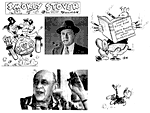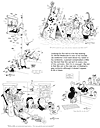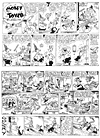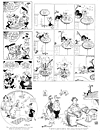| |
Smokestack Foo-mania
The Life and Notary Sojac of Bill
Holman
 Bill
Holman took madcap comedy, pumped it into a comic strip, Smokey Stover, and punned his way to everlasting infoomy. A man of
foo words (as he once said), he managed to parlay them into a living that foo’d
a lifetime. Nonsense could have been his middle name, but whatever it was, it
was always funny in the very best groaning tradition of really good bad puns.
And it all began, as you might imagine, with corn. Bill
Holman took madcap comedy, pumped it into a comic strip, Smokey Stover, and punned his way to everlasting infoomy. A man of
foo words (as he once said), he managed to parlay them into a living that foo’d
a lifetime. Nonsense could have been his middle name, but whatever it was, it
was always funny in the very best groaning tradition of really good bad puns.
And it all began, as you might imagine, with corn.
Through no fault of his own, Holman
was born March 22, 1903, at Offield Crick, near Sugar Crick which was near
Crawfordsville, Indiana, from whence the family soon moved north to Nappanee,
where Bill’s mother ran a millinery store. At an early age, Bill displayed an
interest in drawing and enrolled in the Charles N. Landon correspondence course
in cartooning. He also had a job tending a popcorn machine in the local
five-and-dime store, which, according to Holman, accounts for the prevalence of
corny jokes in his cartoons. Explaining his early inclination to cartooning,
Holman once said he’d indulged a sense of humor and acted silly as a youth,
adding that his father was a “funny guy” but saying no more about him. It’s
possible that the father died or left his family: when Bill was fourteen or
fifteen, they moved to Goshen, Indiana, where, at sixteen, Bill quit school in
order to get a job and earn money for the family. “I worked in a drugstore,
jerking sodas,” Holman said later, “and that was big stuff to me since I made
$2.50 a week and all I could eat.” The Holmans soon left for Chicago, where the
mother worked in millinery again and Bill found a job in the Marshall Field
wholesale house and attended the Chicago Academy of Fine Arts in the evenings.
When he heard that the Chicago Tribune was looking for an
office boy to work in the art department, he applied and was hired. Holman was
jubilant: “I could have kissed everyone in Chicago,” he said later. “I rubbed
shoulders with a lot of famous cartoonists from then on. Carl Ed (Harold Teen) was there, as was Harold
Gray (who later created Little Orphan
Annie). Gray worked in a turtleneck sweater, wore a derby and among other
things was working as a legman for an illustrator. He went out and dug up
illustration work for this guy and then got a percentage of the job. At night,
Gray was doing layouts. I was the office boy, but I did layouts and little
comics to amuse myself, and did all the paste-downs of all the stuff in the
paper—so photos could be squared up and retouched. This was big stuff to me,
and I loved it. E.C. Segar was my idol at the time with his Looping the Loop. Frank King would come
in and Sidney Smith was tops with The
Gumps.”
In 1921, after a couple years doing
layouts and minor art chores at the Chicago
Tribune, Holman went to Cleveland, where he hired on at the Newspaper
Enterprise Association (NEA) syndicate and was soon producing a daily comic
strip, Billville Birds, about Wally
Waddle and his feathered friends. He also did a funny animal strip, J. Rabbit, Esquire, for NEA. Neither
was particularly successful. Once again, Holman was in the company he most aspired
to: “There were a lot of cartoonists there. Wally Allman was drawing Doings of the Duffs, Gene Ahern, Our Boarding House, and all of us
cartoonists were in one cubicle together. We didn’t work at the main NEA
production plant but had an office in the same building that housed the famous
Landon Course. Chic Young had been working as a stenographer in a railroad
office in Chicago; he came to NEA about the time I did, and we roomed together
for a while, Merrill Blosser (Freckles
and His Friends) and Edgar Martin (who started Boots and Her Buddies in 1924) were there also. And I can’t forget
Jim Williams (Out Our Way).”
When Holman was fired in 1924, he
went to New York and joined the newly formed Herald Tribune Syndicate for which
he produced another daily comic strip, G.
Whiz Junior. Again, he was ecstatic about the company he was keeping.
“Winsor McCay, Charlie Voight, Clare Briggs and other famous names were there,”
Holman recalled, “and as a punk, I hung out with damn nice people.” Among them,
“assorted actors, publicists, writers and odd characters who dropped in at all
hours,” Jerry Robinson wrote in The
Comics. Will Rogers came by often, and so did W.C. Fields, who taught
Holman how to juggle.
After seven years and not much
success, Holman abandoned comic strips and took up freelance magazine
cartooning, at which he did much better, selling to Saturday Evening Post, Collier’s, Judge, Life (the humor magazine),
Liberty, Redbook, American Magazine, Film Fun, Ballyhoo, Boy’s Life, and Everybody’s Weekly in London. Said
Holman: “I soon had about thirty markets and was making a hell-of-a-lot of
money.” Accounting for this unexpected success, he said, “I was just being
myself in my cartoons—that was the whole thing. I’d had quite a bit of
experience at various papers and syndicates, and when you find that your
stuff’s appearing before the public in a big national publication, you get
confidence. You unconsciously open up, forget your inhibitions, and do the
things that are the easiest and most normal. You’re not uptight any more.”
In late 1934, Holman heard that
Joseph Patterson, publisher of the New
York Daily News, was looking for a Sunday comic strip that would display
the paper’s civic-minded support of such public servants as policemen and
teachers and, in this case, firemen. “I had sold a lot of firemen cartoons to
magazines,” Holman said, “and the idea of firemen running around all over in
red trucks seemed like a good gimmick to hang things on.” Over Christmas while
visiting his grandmother in Crawfordsville, Holman drew up a sample Sunday
strip and when he returned to New York, he offered it to Patterson. “He
wondered if I could keep it up,” Holman said, “and I told him confidently that
I could.” The manic Smokey Stover debuted
March 10, 1935 and continued with the Tribune-News Syndicate until Holman
retired in 1973.
The title character is a fireman,
Smokestack Stover, and while the strip also features his boss, the fire chief
Cash U. Nutt, the activities just as often involve Smokey’s wife Cookie or his
son Earl or their cat with a perpetually bandaged tail, Spooky, who, for a
time, starred in a companion strip of his own before joining the firehouse
gang. Holman, Stephen Becker said, “threw himself into his work with
unmitigated glee,” adding: “The profession of comic strip artist has supplied
nothing closer to a baggy-pants burlesque comedian than Bill Holman. Holman
wears neither baggy pants nor floppy shoes, and his work has none of the bluish
quality of real burlesque; but his inventiveness, his verbal juxtapositions and
misunderstandings, and his irrepressible manglings of the English language are
the marks of a man to whom reality is subordinate to art.”
The art was the art of the pun, both
visual and verbal. The jokes around which Holman arrayed his maniac word play
were tame left-overs from what pop culture critic Don Phelps calls “decrepit
vaudeville.” One day, the Chief introduces Smokey to an old friend, saying,
“Come on in, Smokey—I want you to meet my old slat happy pal, Major Bedd—he’s
in the camouflage division at Camp Stool.” Smokey, entering the Chief’s office,
says, “Major, huh? What are you doing in a private office?” The Major, putting
his arm around the Chief, says, “I was just tellin’ Nozzle Nose here how we
paint tanks and cannons so they can’t be seen.” That gives Smokey an idea, and
he enlists the Major to paint over his clothing, saying, “My wife’s doing her
spring cleaning this week—just think—now I can loaf around the house without
her seein’ me.” The pictures prop up the lame gag: Smokey’s costume is now
loudly redolent with the outlandish pattern of jungle folliage camouflage,
scarcely inconspicuous let alone invisible.
Holman always enhanced the core
comedy of his strip with sight gags—in this case, punning pictures that echoed
the military theme. Framed pictures on the wall change from panel to panel: one
shows a slipper labeled “army mule”; another, an insect carrying a rifle
labeled “bug private”; next, a dentist leans into an neighboring frame to
minister to his patient over the label “drill sergeant.” But these little
hilarities are not all military. The Chief sits at a table adorned with numbers
and a tag reading, “multiplication table.” The Major smokes a cigar to which is
affixed an ash tray to catch the steadily lengthening ash. (The strip abounds
with inventions of this looney sort, the most persuasive perhaps being the
double-bowl pipe that the Chief often smokes.) The bill of Smokey’s fire helmet
is hinged, and the axe he is carrying has a limp handle. The Chief reacts to
Smokey’s explanation by leaping up and banging his head against the fire gong
on the wall. But this reaction is mild.
In the punchline panels, Holman’s
characters typically do the most outlandish “takes” in comedy: not only do
their hats fly off their heads, their false teeth bound out of their mouths,
and, in a rising crescendo of hysterical visual alarm, their ears depart from
their heads, and the characters leap out of their trousers while other bits of
clothing take off in all directions. Holman’s Sunday strips, Phelps wrote,
“came to resemble anatomies of a garage sale in the Market Place of Oz:
chirping, clucking, and kazoo-ing with the puns that were Holman’s favorite
side-arm ... —a pretty girl’s face with gently flaming locks (Fire Belle); a
bowlful of tiny heads (Noodle Soup); a “Postage Stamp,” in frenzied jig.” One
Sunday, we see the Chief taking a bath, singing, “I wash I was in Dixie—Hooray,
Fooray.” A small plug in the side of the tub is labeled “choo choo drain,” and
on the wall is a picture of two sailors coming out of a barber shop, radiating
cologne and labeled “smelling salts.”
Smokey
Stover, as Phelps observes, is the last lunatic refuge of the “buoyant
absurdity” of such vaudeville and burlesque comedians as Ed Wynn, “with his
ebullient bonnets, pipes, and bicycles,” and Smokey himself, “with his
lima-bean-shaped head, absentee chin, and tongue which lopped out foolishly
like a happy dog’s, was the proper heir of Wynn’s giggling fire chief.”
Apart from its manic imagery and the
kinetic frenzy of its verbal hijinks, the strip achieved lasting fame with a
trio of seemingly meaningless expressions and a provocatively odd piece of
automotive engineering—foo, notary sojac, 1506 nix nix, and a two-wheeled car.
Holman once explained that he had first encountered “foo” in San Franciso’s
Chinatown where it was written on a little jade doll. It meant “good luck,” he
learned, and because it sounded funny, he promptly lettered it on the radiator
grill of a comic car he’d drawn—and, subsequently, on walls, furniture, and
just about anything else that seemed in need of some sort of name. “A man’s foo
is his castle,” reads a sign. A seafood dish is labeled “lobster a la fooburg.”
Familiar phrases are giddily revamped: “Rings on my fingers, foos on my toes”;
“an icicle built for foo”; on the front of a car, “T-foo-2” and on the back,
“2-foo-T.” This innocent monosyllable, says Becker, “is perhaps the best
explanation of Holman’s genius”: that he has made that solitary word “stand up
for thirty years, has used it, so to speak, as every imaginable part of speech,
and has come instantly to be identified by it. If he had achieved the same
results with ‘holy mackerel’ or ‘by gum,’ his would have been a pale success
indeed.”
“Notary sojac” is Holman’s phonetic
spelling of the Gaelic nodlaig sodhach— which
the cartoonist had run across in a newspaper article. Said he: “A guy who
conducted a column in the New York Daily
News got a letter from a reader, asking how you would say ‘Merry Christmas’
in eleven different languages. The editor spelled the various greetings
phonetically, and the one in Gaelic came out sounding like Notary Sojac.”
Amused by the expression, Holman sprinkled it throughout his strip as often as
whimsy prompted, “wishing my readers Merry Christmas throughout the year,” he
said, and sometimes presenting “Yraton Cajos” in its stead. As for “1506 nix
nix,” it was the room number of a bachelor cartoonist friend, Al Posen, who
lived in a hotel. “I began using the phrase,” Holman explained, “—a private
joke between the two of us—as a way of warning girls to stay away from Al’s
room.”
The two-wheeled auto, spewing nuts
and bolts as it jounced along, was so frequently a fixture in the strip that it
was virtually another character, and, therefore, had a name of its own:
Foomobile. Wheels mounted left and right instead of fore and aft like a
bicycle’s, the car’s hood and engine protruded precariously in front of the
wheel base. This gravity-defying novelty inspired countless amateur mechanics
to heroic feats of manufacture in attempts to get such a vehicle to function.
One solved the gravity problem by using radial steel-belted tires that could be
run half-inflated, thereby providing a flat foundation to counter-balance the
front end projection.
Holman often by-lined his strip
“Doctor of Foolosphy” and ended these installment with a wholly extraneous last
panel offering a wacky bit of wisdom: “No one has ever complained of a
parachute not opening.” Or “If all the hot dogs consumed on Sunday were laid
end to end, it would be a lot of baloney.” Under another heading, “Foomous
People,” is a man with a coffee cup balanced on his nose, accompanied by text:
“How about chewing the fat with C. Nesbit Nibble, the chow champ who
distributes all the gusto that people eat their meals with.” Under the same
heading, “We just got wind of the Clops Twins, Cy and Clippity, the breezy
buddies who fly the kite that people get as high as.”
Smokey
Stover picked up client papers
almost at birth, chiefly because a well-known Tribune-News cartoonist, Gaar
Williams, died a month after Holman’s strip started, and when his Strain on the Family Tie ceased shortly
thereafter, Smokey Stover inherited
many of its subscribers. It was a Sunday feature for most of its run, but for a
brief time, starting November 14, 1938, it also appeared daily. In the
mid-forties, Holman added a daily panel cartoon, Nuts and Jolts, to his repertoire; it continued for 28 years, its
comedy heavily reliant on wacky gadgets and inventive uses of ordinary items—in
a movie theater, chairs with arm rests shaped like hands “for bachelors who
like to hold hands in the movies”; a man whose wife has put a filled bathtub
next to her bed for her husband to sleep in because it reduced the danger of
his habitual smoking in bed.
Holman claimed he got interested in
firemen as a boy when he aspired to be one because he was good at playing
checkers. He lost interest, he said, when he learned that fire horses didn’t
harness themselves. His conversation was laced with wise-cracks and his
behavior with a compulsive zaniness—offer him a cigarette, and he’ll take two;
ask for one of his two-fer cigars (the popular “two for a nickle” brand), and
he’ll charge you a dime for it. His sense of humor extended to practical jokes:
he once humiliated a waiter in a restaurant by loudly complaining about how
stale the bread was, referring to a week-old slice he’d brought with him for
the purpose and banging it loudly on the table to demonstrate its inedibility.
Reportedly, Holman was a methodical
worker, starting every day at 10 a.m. and working until 6 p.m. without stopping
for lunch. When not socializing with friends and popping popcorn in their
kitchens during their parties (an occupational inheritance from his youth), he
liked to swim, play gin rummy, and indulge a fondness for red-haired women. He
remained a bachelor until rather late in life, marrying a redhead named Dolores
in the late 1940s. Thereafter, he enjoyed being at home.
“My wife sometimes gets irritated at
me because I was always thinking about my work,” Holman told Jud Hurd during an
interview for Cartoonist PROfiles. “I
would sit all evening at home, working on material, rather than going to a
movie, which, to me, is wasting time. I’d rather do this than go out on some
guy’s boat and fish for two hours because fishing, to me, is repetitious—if
you’ve caught one fish, you’ve caught ‘em all.”
They had no children.
During World War II, Holman joined
other New York cartoonists in making regular visits to area military hospitals
to entertain the convalescing troops. According to Becker, Holman would
typically stride onto the platform, cigar clamped in his teeth, fireman’s
helmet on his head, stare at his silent audience for a few minutes and then
yell: “Shut up, you crazy screwballs!” According to report (perhaps legend), he
once performed before GIs who were all psychiatric patients. Warned not to
allude to their mental states, he called them nuts and screwballs throughout
his presentation. Apparently, they loved it.
When these trips resulted in the
founding of the National Cartoonists Society in 1946, Holman was an active
member of the group, becoming president, 1961-1963. He died February 27,
1987,in New York City, where he lived since first arriving there in the early
1920s.
With Smokey Stover, Holman successfully prolonged the life of robust,
good-natured slapstick nonsense humor in comics. “He wedded idiocy to real
wit,” Becker wrote, “and the result is a constantly surprising, never
disappointing comic strip.” It followed “no logic but that of the artist’s own
mad sense of humor,” said Dennis Wepman (in Goulart), producing “a lively and
inventive strip that survived long after the end of a simpler, cheerier era
that gave it birth.”
 |
 |
Sources. Most of the biographical
information in the standard reference works on cartooning (The World Encyclopedia of Comics, ed. Maurice Horn, 1999, and The Encyclopedia of American Comics from
1897 to the Present, ed. Ron Goulart, 1990) seems based mostly upon Jud
Hurd’s interview with Holman in Cartoonist
PROfiles, No. 37, March 1978. Stephen Becker in his Comic Art in America (1959) and Jerry Robinson in his The Comics: An Illustrated History of Comic
Strip Art (1974) add a little, particularly in terms of assessment and
appreciation. Don Phelps’ article, “Disorderly Conduct,” in Nemo: The Classic Comics Library No. 1,
Screwball Comics (1985), supplies an enthusiastic albeit typically baroque
analysis. An article in Froth,
December 1939, “Of Firemen and Foo” by John M. Price, is chiefly manufactured
out of Holman’s own zany autobiographical fabrications. The New York Times obituary March 21, 1987, the only one I know of,
is too short to be worth much.
Return to Harv's Hindsights |